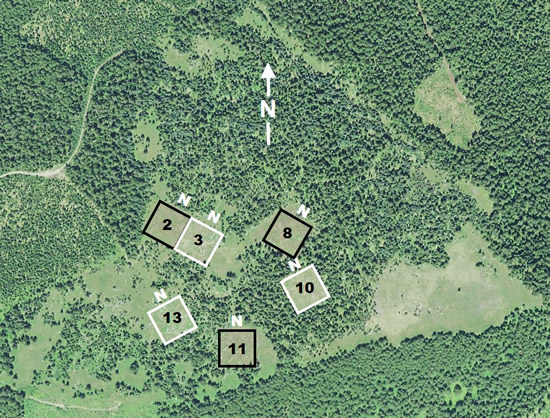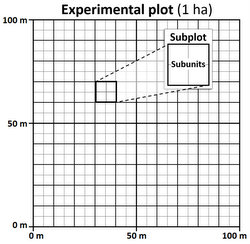| Restoration of conifer-invaded meadows requires tree removal and possibly fire, but restoration efforts may be compromised by rapid reinvasion of tree seedlings. Here, we assess patterns of conifer reinvasion of the experimental plots 8 years after tree removal. We explored
- variation in the timing, composition, and density of establishment
- effects of treatment (burned vs. unburned)
- relationships with distance to, and characteristics of, adjacent residual forests
Methods
_3 Jul 2013_250 x 166.jpg) |
| International exchange student, Nicolas Kremer (right) and undergrad assistant, Shan Kothari, sampling tree seedlings. |
|
Sampling. Within each of the six experimental plots, we subdivided the 10 x 10 m subplots into 5 x 5 m subunits (see layout, below right). We then located all seedlings >5 cm tall, recorded species, measured height, and determined age from bud-scale scars.
To characterize the influences of adjacent forests (e.g., seed production or shading), we measured the diameters of trees (≥10 cm dbh) in a 20- or 30-m-wide band around each plot. Density and basal area were then computed; height was predicted using existing diameter-height equations.
Analyses. We developed cumulative-establishment curves to assess the timing of establishment of each species. We developed a two-dimensional density map for each plot to display the spatial distributions of seedlings.
We used t-tests to compare cumulative seedling density (1) betwen burned and unburned treatments and (2) between S (shaded) and N (exposed) edges (to varying distances from the edge). We used regression to determine whether adjacent forest structure (density, basal area, and height of neighboring trees) predicted plot-level density of seedlings.
 |
| Aerial photograph showing 1-ha tree-removal plots relative to adjacent forests and natural meadows. Plots outlined in black were broadcast burned; plots outlined in white were pile- burned, leaving 90% of the ground surface unburned. North edges are denoted by "N". |
|
| Kremer, N. J., C. B. Halpern, and J. A. Antos. 2014. Conifer reinvasion of montane meadows following experimental tree removal and prescribed burning. Forest Ecology and Management 319:128-137. Request reprint |
|
![]()
![]()
![]()
![]()
_11 Jul 2013_150x112.jpg)
_Plot 2(1)_15 Jul 2013_199x293.jpg)
_3 Jul 2013_199x293.jpg)

_3 Jul 2013_250 x 166.jpg)
